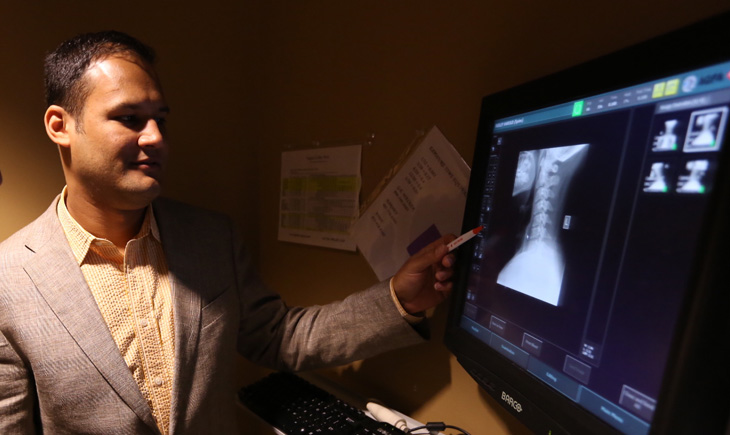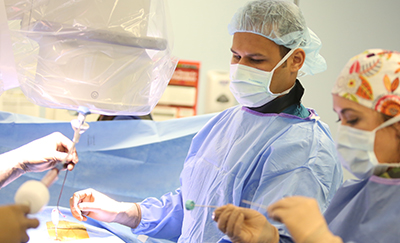 Diagnostic testing methods
Diagnostic testing methods
Evaluation of back and neck pain requires a physician experienced in diagnosing spinal conditions. The work-up begins with a detailed history and physical examination. Your medical history helps the doctor understand your back and neck pain and the influence of your lifestyle on your pain.
During your physical exam, your physician will try to pinpoint the source of pain. Simple tests for flexibility and muscle strength may also be conducted. Diagnostic tests may be ordered to confirm the location and source of your pain.
Diagnostics may include:
- X-rays are usually the first step in diagnostic testing methods. X-rays show bones and the spaces between the bones.
- MRI (magnetic resonance imaging) uses a magnetic field and radio waves to generate highly-detailed pictures of the inside of your body. Because X-rays only show bones, MRIs are needed to see soft tissues like discs in the spine. These images help your doctor provide a more accurate diagnosis. This type of imaging is very safe and usually pain free.
- CT scan/myelogram - A CT scan is similar to an MRI in that it provides more diagnostic information about the internal structures of the spine. A myelogram is used to diagnose a bulging disc, tumor or changes in the bones surrounding the spinal cord or nerves. A local anesthetic is injected into your low back to numb the area. A lumbar puncture (spinal tap) is then performed. A dye is injected into the spinal canal to reveal where problems lie.
- Electrodiagnostic - Electrical testing of the nerves and spinal cord may be performed as part of our diagnostic workups. These tests, called Electromyography (EMG) or Somato Sensory Evoked Potentials (SSEP), assist your spine surgeon in understanding how your nerves or spinal cord are affected by your condition.
- Bone Scan - Bone imaging is used to detect infection, malignancy, fractures and arthritis in any part of the skeleton. Bone scans are also used for finding lesions for biopsy or excision.
- Discography - Discography is used to determine the internal structure of your disc. It is performed by using a local anesthetic and injecting a dye into your disc under X-ray guidance. An X-ray and CT scan are performed to view the appearance of the disc composition to determine if its structure is normal or abnormal. In addition to your disc appearance, your doctor will note if you have pain with this injection. The benefit of a discogram is that it enables the spine surgeon to confirm which disc level is really causing your pain. This ensures that surgery will be more successful and reduces the risk of operating on the wrong disc.
- Injections - Pain-relieving injections can relieve back pain and give the physician important information about the problem, as well as provide a bridge therapy.

[Top]
Maahir Haque, MD is recognized as a leader in the field of minimally invasive spine surgery. At Spine Group Orlando, Dr. Maahir Haque also provides second opinions for spine surgery and MRI reviews for those with back pain and neck pain. Dr. Haque emphasizes non-surgical options for back pain and neck pain where possible. This can include accessing a back pain specialist with expertise in pain-relieving spinal injections and spine therapists. Spine therapy can include back stretches that can be a future home remedy for back pain or neck pain. If spine surgery is necessary because of a herniated disc, spinal fracture, or spinal stenosis, Dr. Maahir Haque operates through tubular retractors that reduce the size of the incision, lessen blood loss, reduce time in the hospital, speed return to activity with a less painful recovery. This spine surgery expertise enables many patients to have outpatient spine surgery and be home the same day. Spine Group Orlando and Dr. Maahir Haque provides artificial disc replacement in the neck using the Mobi-C disc implant, the first FDA-approved disc for multiple levels in the neck. Prodisc-C is also used for artificial disc replacement in the cervical spine. Dr. Haque is also one of the few spine surgeons in Orlando, Florida to provide lumbar artificial disc replacement using the Prodisc-L artificial disc. Dr. Haque is also referred patients from across Orlando and north central Florida for artificial disc replacement surgery as an alternative to spinal fusion. Accordingly, Dr. Haque's patients travel from across north central Florida, including: Orlando; Jacksonville; Tallahassee; Lakeland; Gainesville; Tampa; Daytona Beach; and Cocoa Beach. The spine center, as a destination for medical tourism for some international patients from Mexico and the Caribbean, can provide recommendations to out-of-town patients on nearby hotels and tourist attractions. Dr. Haque is featured on the national site CentersforArtificialDisc.com as an author on the subject of artificial disc replacement for herniated discs in the neck. The Centers for Artificial Disc web site has content specific to disc replacement options and alternatives to spinal fusion. Click here to visit the Centers for Artificial Disc.







